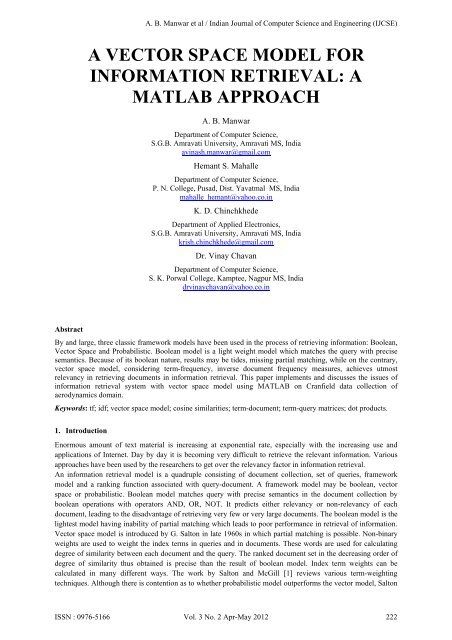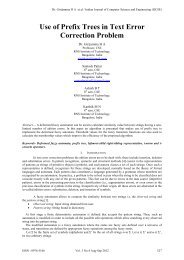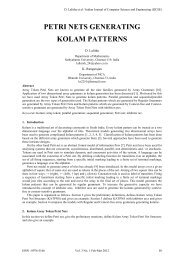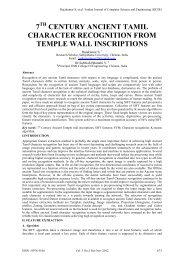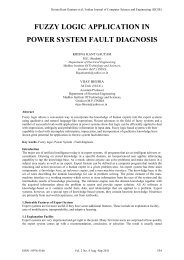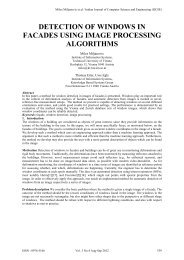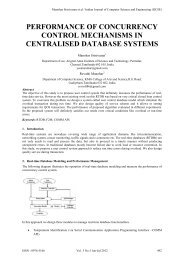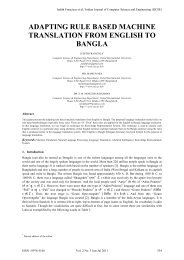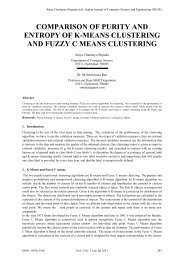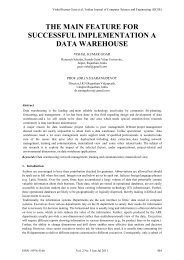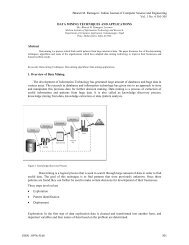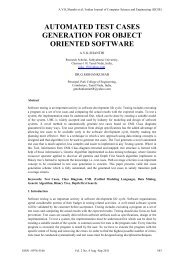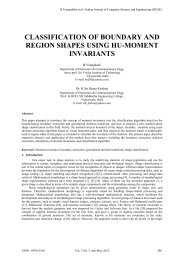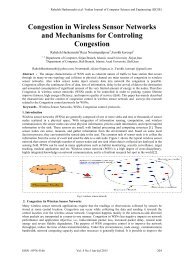a vector space model for information retrieval: a matlab approach
a vector space model for information retrieval: a matlab approach
a vector space model for information retrieval: a matlab approach
You also want an ePaper? Increase the reach of your titles
YUMPU automatically turns print PDFs into web optimized ePapers that Google loves.
A. B. Manwar et al / Indian Journal of Computer Science and Engineering (IJCSE)<br />
A VECTOR SPACE MODEL FOR<br />
INFORMATION RETRIEVAL: A<br />
MATLAB APPROACH<br />
A. B. Manwar<br />
Department of Computer Science,<br />
S.G.B. Amravati University, Amravati MS, India<br />
avinash.manwar@gmail.com<br />
Hemant S. Mahalle<br />
Department of Computer Science,<br />
P. N. College, Pusad, Dist. Yavatmal MS, India<br />
mahalle_hemant@yahoo.co.in<br />
K. D. Chinchkhede<br />
Department of Applied Electronics,<br />
S.G.B. Amravati University, Amravati MS, India<br />
krish.chinchkhede@gmail.com<br />
Dr. Vinay Chavan<br />
Department of Computer Science,<br />
S. K. Porwal College, Kamptee, Nagpur MS, India<br />
drvinaychavan@yahoo.co.in<br />
Abstract<br />
By and large, three classic framework <strong>model</strong>s have been used in the process of retrieving in<strong>for</strong>mation: Boolean,<br />
Vector Space and Probabilistic. Boolean <strong>model</strong> is a light weight <strong>model</strong> which matches the query with precise<br />
semantics. Because of its boolean nature, results may be tides, missing partial matching, while on the contrary,<br />
<strong>vector</strong> <strong>space</strong> <strong>model</strong>, considering term-frequency, inverse document frequency measures, achieves utmost<br />
relevancy in retrieving documents in in<strong>for</strong>mation <strong>retrieval</strong>. This paper implements and discusses the issues of<br />
in<strong>for</strong>mation <strong>retrieval</strong> system with <strong>vector</strong> <strong>space</strong> <strong>model</strong> using MATLAB on Cranfield data collection of<br />
aerodynamics domain.<br />
Keywords: tf; idf; <strong>vector</strong> <strong>space</strong> <strong>model</strong>; cosine similarities; term-document; term-query matrices; dot products.<br />
1. Introduction<br />
Enormous amount of text material is increasing at exponential rate, especially with the increasing use and<br />
applications of Internet. Day by day it is becoming very difficult to retrieve the relevant in<strong>for</strong>mation. Various<br />
<strong>approach</strong>es have been used by the researchers to get over the relevancy factor in in<strong>for</strong>mation <strong>retrieval</strong>.<br />
An in<strong>for</strong>mation <strong>retrieval</strong> <strong>model</strong> is a quadruple consisting of document collection, set of queries, framework<br />
<strong>model</strong> and a ranking function associated with query-document. A framework <strong>model</strong> may be boolean, <strong>vector</strong><br />
<strong>space</strong> or probabilistic. Boolean <strong>model</strong> matches query with precise semantics in the document collection by<br />
boolean operations with operators AND, OR, NOT. It predicts either relevancy or non-relevancy of each<br />
document, leading to the disadvantage of retrieving very few or very large documents. The boolean <strong>model</strong> is the<br />
lightest <strong>model</strong> having inability of partial matching which leads to poor per<strong>for</strong>mance in <strong>retrieval</strong> of in<strong>for</strong>mation.<br />
Vector <strong>space</strong> <strong>model</strong> is introduced by G. Salton in late 1960s in which partial matching is possible. Non-binary<br />
weights are used to weight the index terms in queries and in documents. These words are used <strong>for</strong> calculating<br />
degree of similarity between each document and the query. The ranked document set in the decreasing order of<br />
degree of similarity thus obtained is precise than the result of boolean <strong>model</strong>. Index term weights can be<br />
calculated in many different ways. The work by Salton and McGill [1] reviews various term-weighting<br />
techniques. Although there is contention as to whether probabilistic <strong>model</strong> outper<strong>for</strong>ms the <strong>vector</strong> <strong>model</strong>, Salton<br />
ISSN : 0976-5166 Vol. 3 No. 2 Apr-May 2012 222
A. B. Manwar et al / Indian Journal of Computer Science and Engineering (IJCSE)<br />
and Buckley [2] showed that the <strong>vector</strong> <strong>model</strong> is expected to outper<strong>for</strong>m the probabilistic <strong>model</strong> with general<br />
collections [3].<br />
This paper implements and discusses the issues of in<strong>for</strong>mation <strong>retrieval</strong> system with <strong>vector</strong> <strong>space</strong> <strong>model</strong> using<br />
MATLAB on Cranfield data collection of aerodynamics domain.<br />
The next section deals with brief review of related work of <strong>vector</strong> <strong>space</strong> <strong>model</strong> in in<strong>for</strong>mation <strong>retrieval</strong>.<br />
2. Related work<br />
Maron and Kuhns [4] in early 1960, described probabilistic indexing technique in a mechanized library system<br />
yielding probable relevance. Afterword in 1983, Salton and McGill wrote a book [1] which discusses thoroughly<br />
the three classic <strong>model</strong>s in in<strong>for</strong>mation <strong>retrieval</strong> namely, the boolean, the <strong>vector</strong>, and the probabilistic <strong>model</strong>s.<br />
The book by van Rijsbergen [5] covers the discussion on three classic <strong>model</strong>s and majority of the associated<br />
technology of <strong>retrieval</strong> system. Frakes and Baeza-Yates [6] edited the book on in<strong>for</strong>mation <strong>retrieval</strong> which<br />
mainly deals with the data structures used in general in<strong>for</strong>mation <strong>retrieval</strong> systems. Also, it includes the issue of<br />
relevance feedback as well as some query modification techniques [7] and Boolean operations and their<br />
implementations [8]. Verhoeff, Goffman, and Belzer [9] described the shortfall of boolean queries <strong>for</strong><br />
in<strong>for</strong>mation <strong>retrieval</strong>. The concept of using boolean <strong>for</strong>malism in other frameworks had been the great interest<br />
area of the researchers. Lee et al proposed a thesaurus-based boolean <strong>retrieval</strong> system <strong>for</strong> ranking [10].<br />
Vector <strong>space</strong> <strong>model</strong> has been the most popular <strong>model</strong> in in<strong>for</strong>mation <strong>retrieval</strong> among the research vicinity<br />
because of the research outcome in indexing, term value specification in automatic indexing carried out by<br />
Salton and his associates [11, 12]. Most of this research deals with experiments in automatic document<br />
processing and different term weighting <strong>approach</strong>es <strong>for</strong> automatic <strong>retrieval</strong> [2, 13]. In 1972, Karen Sparck Jones<br />
introduced the concept of inverse document frequency, a measure of specificity [14, 15] and Salton and Yang<br />
uses it <strong>for</strong> automatic indexing to improve <strong>retrieval</strong> [12]. Raghavan and Wong [16] analyses <strong>vector</strong> <strong>space</strong> <strong>model</strong><br />
critically with the conclusion that the <strong>vector</strong> <strong>space</strong> <strong>model</strong> is useful and which provides a <strong>for</strong>mal framework <strong>for</strong><br />
the in<strong>for</strong>mation <strong>retrieval</strong> systems.<br />
The next section gives a description of the most influential <strong>vector</strong> <strong>space</strong> <strong>model</strong> in modern in<strong>for</strong>mation <strong>retrieval</strong><br />
research.<br />
3. Vector Space Model<br />
The drawback of binary weight assignments in boolean <strong>model</strong> is remediated in the <strong>vector</strong> <strong>space</strong> <strong>model</strong> which<br />
projects a framework in which partial matching is possible [11, 13]. Non-binary weights <strong>for</strong> index terms in<br />
queries and documents are used in the calculation of degree of similarity. Decreasing order of this degree of<br />
similarity <strong>for</strong> the retrieved documents gives the ranked documents with partial match.<br />
For the <strong>vector</strong> <strong>model</strong>, the weight , associated with a pair , is positive and non-binary. Further, the<br />
index terms in the query are also weighted. Let , be the weight associated with the pair ,, where<br />
, 0. Then, the query <strong>vector</strong> is defined as , , , ,…, , where t is the total number of index<br />
terms in the system. The <strong>vector</strong> <strong>for</strong> a document d j is represented by , , , ,…, , .<br />
The <strong>vector</strong> <strong>model</strong> proposes to evaluate the degree of similarity of the document d j with regard to the query q as<br />
the correlation between the <strong>vector</strong>s and . This correlation can be measured by the cosine of the angle<br />
between these two <strong>vector</strong>s as,<br />
, <br />
<br />
⋅<br />
<br />
||<br />
<br />
<br />
∑<br />
<br />
, ,<br />
<br />
∑ <br />
<br />
, ∑<br />
<br />
<br />
,<br />
where and || are the norms of the document and query <strong>vector</strong>s. The factor || does not affect the ranking<br />
(i.e., the ordering of the documents) because it is the same <strong>for</strong> all documents. The factor provides<br />
normalization in the <strong>space</strong> of the documents.<br />
Since , 0 and , 0, , varies from 0 to +1, the <strong>vector</strong> <strong>model</strong> ranks the documents according to<br />
their degree of similarity to the query. A document might be retrieved even if it matches the query only<br />
partially. [3, page 27-28].<br />
ISSN : 0976-5166 Vol. 3 No. 2 Apr-May 2012 223
A. B. Manwar et al / Indian Journal of Computer Science and Engineering (IJCSE)<br />
In the <strong>vector</strong> <strong>space</strong> <strong>model</strong>, the frequency of a term k i inside a document d j referred to as the tf factor and<br />
provides one measure of how well that term describes the document contents. Furthermore, the inverse of the<br />
frequency of a term k i among the documents in the collection referred to as the inverse document frequency or<br />
the idf factor.<br />
The normalized frequency f i,j of term k i in document d j is given by<br />
, <br />
,<br />
,<br />
(1)<br />
where the maximum is computed over all terms which are mentioned in the text of the document d j . The idf i ,<br />
inverse document frequency <strong>for</strong> k i , be given by<br />
<br />
(2)<br />
The best known term-weighting schemes use weights which are given by<br />
, , <br />
(3)<br />
Such term-weighting strategies are called tf-idf schemes [3, page 29-30].<br />
The success of <strong>vector</strong> <strong>space</strong> <strong>model</strong> lies in its term-weighting scheme, its partial matching strategy and similarity<br />
measure. Mutual independence of index terms has said to be disadvantage of <strong>vector</strong> <strong>space</strong> <strong>model</strong> but practically,<br />
consideration of term dependencies is not fruitful. From the research consequence in the field, it seems that the<br />
<strong>vector</strong> <strong>model</strong> is either superior or almost as good as the known alternatives.<br />
4. Experimental Evaluations<br />
4.1. Dataset <strong>for</strong> in<strong>for</strong>mation <strong>retrieval</strong> system<br />
We used a Cranfield collection having 1398 abstracts related to aerodynamics domain which is obtained from<br />
[17]. The collection contains a compressed version of document text, relation giving relevance judgements, text<br />
of 225 queries, indexed documents and indexed queries. Also, we used stop-list obtained from the collection<br />
source.<br />
4.2. Preprocessing<br />
The compressed version of document text has been preprocessed to obtain a set of 1398 individual abstract files.<br />
A PHP script has been written <strong>for</strong> this purpose. Stemming has not applied <strong>for</strong> the reasons of i) losing context of<br />
search, ii) may reduces precision and iii) can not be applied to proper nouns. To have a clear view of relevancy,<br />
instead of using given set of query and relevance judgements, we have created our set of queries from ‘titles’ of<br />
1398 documents, <strong>for</strong>ming a query set of 1398 entities.<br />
4.3. Implementation<br />
A MATLAB is used to implement a <strong>vector</strong> <strong>space</strong> <strong>model</strong> <strong>for</strong> in<strong>for</strong>mation <strong>retrieval</strong>; the complete process is<br />
depicted in fig. 1.<br />
ISSN : 0976-5166 Vol. 3 No. 2 Apr-May 2012 224
A. B. Manwar et al / Indian Journal of Computer Science and Engineering (IJCSE)<br />
Fig. 1. Implementation of <strong>vector</strong> <strong>space</strong> <strong>model</strong> <strong>for</strong> in<strong>for</strong>mation <strong>retrieval</strong>.<br />
As shown in block diagram it consists of three stages:<br />
1. Generation of Term-Frequency matrix<br />
It is term-frequency matrix of all unique terms in document with 1,2, … , . The term document<br />
matrix (FM) is matrix with unique terms in dictionary<br />
1,2,…, and <br />
documents. The elements of FM are represented as , in which each element indicates the frequency<br />
of term in document.<br />
The Cranfield data collectiont is preprocessed to convert into individual 1398 text files. A SMART<br />
stop word text file which is available with the dataset is used <strong>for</strong> the removal of stop words from the<br />
data collection of 1398 files. Also, non-embedding special characters and numerals have been removed<br />
from these files. 79,728 words have been collected which are then processed to find the frequency of<br />
unique words in each documents. The dictionary of unique words is of 7805 words. Thus the termfrequency<br />
matrix is of size 7805x1398.<br />
2. Generation of Query matrix<br />
The title of each abstract, after removing stop-list words and non-embedding special characters is used<br />
as query, which contributes to the set of 1398 unique queries represented as . Here, we have taken<br />
queries as titles of the document instead of the dataset queries so as to judge the relevancy more<br />
profoundly. The generated matrix <strong>for</strong> 1398 queries is .<br />
3. Term-weight calculations and result<br />
A term-frequency matrix is processed to get the term weights considering tf-idf scheme. These term<br />
weights are calculated by the <strong>for</strong>mula /, where<br />
, is the term-weight i.e. weight of term in document ,<br />
, is the frequency of term in document ,<br />
is the inverse document frequency representing the terms appearing in many<br />
documents and is calculated by the <strong>for</strong>mula log , where is the total number of<br />
<br />
<br />
documents and is the number of documents containing term ,<br />
is the Euclidean length obtaining by taking square root of sum of squares of<br />
individual terms per document.<br />
ISSN : 0976-5166 Vol. 3 No. 2 Apr-May 2012 225
A. B. Manwar et al / Indian Journal of Computer Science and Engineering (IJCSE)<br />
Query matrix of size is also divided by their corresponding Euclidean lengths to obtain the<br />
normalized weights. For query , the transpose of query matrix is multiplied by the term-weight matrix.<br />
The final result is obtained by ordering the weights in a result matrix in decreasing manner of their weights.<br />
4.4. Testing phase<br />
The <strong>vector</strong> <strong>space</strong> <strong>model</strong> (VSM) implemented above is tested thoroughly in different ways, the details of<br />
experimentation is explained below:<br />
Fig. 2 shows the distribution of index terms in dictionary <strong>for</strong> individual documents. The dictionary consists<br />
of 7805 unique terms.<br />
Fig. 2. Index terms in a dictionary<br />
Fig. 3 shows frequency count of each unique term in dictionary distributed in complete dataset. Some of the<br />
unique terms such as (‘flow’, 2059), (‘pressure’, 1245), (‘boundary’, 1076), (‘results’, 897), with high<br />
frequency in entire documents is shown.<br />
Fig. 3. Frequency count of each unique term among data collection<br />
Further looking into the dataset, as shown in fig. 4, shows subset of 380 documents out of 1398 abstracts. In<br />
document 329 the total terms are 342 but the unique terms are only 162.<br />
ISSN : 0976-5166 Vol. 3 No. 2 Apr-May 2012 226
A. B. Manwar et al / Indian Journal of Computer Science and Engineering (IJCSE)<br />
Fig. 4. Document-wise total and unique terms<br />
Table I is the subset of 20 queries out of 1398 tested queries against the <strong>vector</strong> <strong>space</strong> <strong>model</strong> <strong>for</strong> <strong>retrieval</strong> of<br />
relevant documents. In the present study the most relevant document is one whose ID matches with query<br />
ID.<br />
Table I is the subset of 20 queries out of 1398 tested queries against the <strong>vector</strong> <strong>space</strong> <strong>model</strong> <strong>for</strong> <strong>retrieval</strong> of<br />
relevant documents. In the present study the most relevant document is one whose ID matches with query<br />
ID.<br />
Table 1. Subset of 20 queries<br />
Q.ID<br />
Details of Queries<br />
1 experimental investigation of the aerodynamics of a wing in a slipstream .<br />
2 simple shear flow past a flat plate in an incompressible fluid of small viscosity .<br />
3 the boundary layer in simple shear flow past a flat plate .<br />
4 approximate solutions of the incompressible laminar boundary layer equations <strong>for</strong> a plate in shear flow .<br />
5 one-dimensional transient heat conduction into a double-layer slab subjected to a linear heat input <strong>for</strong> a small time internal .<br />
6 one-dimensional transient heat flow in a multilayer slab .<br />
7 the effect of controlled three-dimensional roughness on boundary layer transition at supersonic speeds .<br />
8 measurements of the effect of two-dimensional and three-dimensional roughness elements on boundary layer transition .<br />
9 transition studies and skin friction measurements on an insulated flat plate at a mach number of 5.8 .<br />
10 the theory of the impact tube at low pressure .<br />
11 similar solutions in compressible laminar free mixing problems .<br />
12 some structural and aerelastic considerations of high speed flight .<br />
13 similarity laws <strong>for</strong> stressing heated wings .<br />
14 piston theory - a new aerodynamic tool <strong>for</strong> the aeroelastician .<br />
15 on two-dimensional panel flutter .<br />
16 trans<strong>for</strong>mation of the compressible turbulent boundary layer .<br />
17 remarks on the eddy viscosity in compressible mixing flows .<br />
18 the flow field in the diffuser of a radial compressor .<br />
19 an investigation of the pressure distribution on conical bodies in hypersonic flows .<br />
20 generalised-newtonian theory .<br />
The result of experimentation is tabulated in Table 2 shown below:<br />
ISSN : 0976-5166 Vol. 3 No. 2 Apr-May 2012 227
A. B. Manwar et al / Indian Journal of Computer Science and Engineering (IJCSE)<br />
Table 2. Tabulation of results of first ten queries<br />
Further query wise details are depicted in subsequent Table 3 to Table 5 respectively.<br />
Table 3. Frequency of terms in retrieved document set <strong>for</strong> query 1<br />
Table 4. Frequency of terms in retrieved document set <strong>for</strong> query 2<br />
Table 5. Frequency of terms in retrieved document set <strong>for</strong> query 3<br />
ISSN : 0976-5166 Vol. 3 No. 2 Apr-May 2012 228
A. B. Manwar et al / Indian Journal of Computer Science and Engineering (IJCSE)<br />
Table 3 depicts the result obtained <strong>for</strong> query 1 with query terms and their occurrences in the documents. First 18<br />
documents are listed. Similar results are shown in table 4 and table 5 <strong>for</strong> queries 2 and 3 respectively.<br />
5. Results and discussion<br />
Even after taking the ‘titles’ of the abstract documents as a query set, the final result of <strong>retrieval</strong> is 89.41%. 148<br />
queries have not shown result as first retrieved document; however, within the range of first two retrieved<br />
documents, the result obtained is 94.99%. 2.22% of queries have not retrieved the correct result up to the range<br />
of first five documents.<br />
Inter-document characterization and document frequency plays vital role in building ranks of the documents in<br />
<strong>vector</strong> <strong>space</strong> <strong>model</strong>. As such, term frequency of the documents d 3 , d 389 and d 2 is 24, 42 and 110 respectively; and<br />
the frequency of terms ‘flow’, ‘plate’ and ‘small’ in all documents is 2059, 421 and 306 respectively, which is<br />
much more higher than the average frequency- as a result, table IV shows the outcome of query q 2 as document<br />
d 3 ; however, expected relevant document is d 2 . Variety of the weight calculation <strong>for</strong>mulas as suggested by<br />
Salton and Buckley [2] have been tested on this collection but we found that the standard tf-idf weighting<br />
scheme gives the best results.<br />
References<br />
[1] G. Salton and M. J. McGill. Introduction to Modern In<strong>for</strong>mation Retrieval. McGraw-Hill Book Co., New York, 1983.<br />
[2] G. Salton and C. Buckley. Term-weighting <strong>approach</strong>es in automatic <strong>retrieval</strong>. In<strong>for</strong>mation Processing and Management,<br />
24(5):513-523, 1988.<br />
[3] Christopher D. Manning, Prabhakar Raghavan, and Hinrich Schutze, Introduction to In<strong>for</strong>mation Retrieval, Cambridge<br />
University Press, New York, USA, 2008.<br />
[4] M. E. Maron and J. L. Kuhns. On relevance, probabilistic indexing and in<strong>for</strong>mation <strong>retrieval</strong>. Association <strong>for</strong> Computing<br />
Machinery, 7(3):216-244, 1960.<br />
[5] C. J. van Rijsbergen. In<strong>for</strong>mation Retrieval. Butterworths, London, 1979.<br />
[6] W. B. Frakes and R. Baeza-Yates. In<strong>for</strong>mation Retrieval: Data Structures and Algorithms. Prentice Hall, Englewood Cliffs, NJ,<br />
USA, 1992.<br />
[7] D. Harman. Relevance feedback and other query modification techniques. In W. B. Frakes and R. Baeza-Yates, editors,<br />
In<strong>for</strong>mation Retrieval: Data Structures and Algorithms, pages 241-263. Prentice Hall, Englewood Cliffs, NJ, USA, 1992.<br />
[8] S. Wartick. Boolean operations. In W. B. Frakes and R. Baeza-Yates, editors, In<strong>for</strong>mation Retrieval: Data Structures and<br />
Algorithms, pages 264-292. Prentice Hall, Englewood Cliffs, NJ, USA, 1992.<br />
[9] J. Verhoeff, W. Goffmann, and Jack Belzer. Inefficiency of the use of Boolean functions <strong>for</strong> in<strong>for</strong>mation <strong>retrieval</strong> systems.<br />
Communications of the ACM, 4(12):557-558, 594, December 1961.<br />
[10] J. H. Lee, W. Y. Kim, and Y. H. Lee. Ranking documents in thesaurus-based Boolean <strong>retrieval</strong> systems. In<strong>for</strong>mation Processing<br />
and Management, 30(1):79-91, 1993.<br />
[11] G. Salton and M. E. Lesk. Computer evaluation of indexing and text processing. Journal of the ACM, 15(1):8-36, January 1968.<br />
[12] Gerad Salton and C. S. Yang. On the specification of term values in automatic indexing. Journal of Documentation, 29:351-372,<br />
1973.<br />
[13] G. Salton. The SMART Retrieval System – Experiments in Automatic Document Processing. Prentice Hall Inc., Englewood<br />
Cliffs, NJ, 1971.<br />
[14] K. Sparck Jones. A statistical interpretation of term specificity and its application to <strong>retrieval</strong>. Journal of Documentation,<br />
28(1):11-20, 1972.<br />
[15] K. Sparck Jones. A statistical interpretation of term specificity and its application to <strong>retrieval</strong>. In<strong>for</strong>mation Storage and Retrieval,<br />
9(11):619-633, 1973.<br />
[16] V. V. Raghavan and S. K. M. Wong. A critical analysis of <strong>vector</strong> <strong>space</strong> <strong>model</strong> <strong>for</strong> in<strong>for</strong>mation <strong>retrieval</strong>. Journal of the American<br />
Society <strong>for</strong> In<strong>for</strong>mation Sciences, 37(5):279-287, 1986.<br />
[17] ftp server of Cornell University ftp://ftp.cs.cornell.edu/pub/smart/cran/ <strong>for</strong> Cranfield collection.<br />
ISSN : 0976-5166 Vol. 3 No. 2 Apr-May 2012 229


